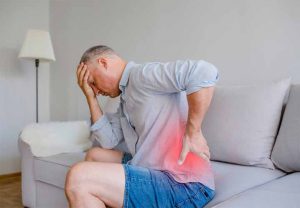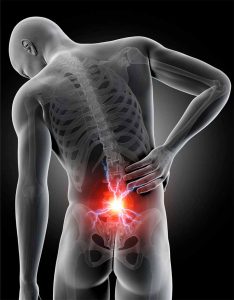Table of Contents
Lumbago Overview
Lumbago is the descriptive word for low(lower) back pain, and the two words are frequently used interchangeably. The pain usually occurs in the lumbar area.
People suffering from lumbago, a common musculoskeletal condition, frequently find it difficult to enjoy the daily activities that used to bring them happiness. What exactly is lumbago? Essentially, this condition refers to pain in the lower back area. If you have lumbago, you are not alone; approximately 80% of the Western world population suffers from it. Maybe you have lower back pain but aren’t sure if it’s lumbago.
Common Signs & Symptoms
- The principal symptoms include pain in the lumbar region of the spine.
- Stiffness in the lower back, muscle tension in those areas, and achiness are common symptoms of this pain. Mobility can be hampered in the worst-case scenario.
- Localized pain, which means it is limited to a specific region(usually the lumbar region).
- Restricted mobility of the spine, such as when bending over or leaning backward, could be a symptom.
- Another sign of lumbago is a pain in the lower back that spreads to the buttock, groin, or even in the back of the leg.
- Sciatica is characterized by numbness in the buttocks, back, or leg, as well as a tingling sensation that radiates down the leg to the feet. When the sciatic nerve is irritated or compressed.
- swelling in the back of the leg or inflammation of the leg(back) can be a warning sign.
- Lower back pain when sneezing or coughing may also indicate lumbago.

Cause
- Even after extensive medical testing, the cause of lumbago can be difficult to determine. Lumbago can be caused by a variety of causes, the most common of which are overuse of the lower back and sudden raising of a heavy load.
- Lumbago is caused by repeated bending or other regular movements of the lower back. Osteoarthritis and spinal arthritis (spondylosis) may also be contributing factors.
- Other possible causes include a slipped or herniated disc, osteoporosis, spinal stenosis or nerve compression, scoliosis, and malignant or benign spinal tumors.
Read Greenstick Fracture
Treatment Procedure
Treatment of lumbago varies based on a variety of factors, including the age of the patient, weight, activity level, and several others.
- Anti-inflammatory drugs(pain killers)
- Hot or cold massage(compression)
- Exercise to increase flexibility
- The acupuncture
- chiropractic & spinal manipulation
- Physiotherapy
- Surgical treatment
As we completed the short discussion of lumbago. Now, we’ll discuss lumbago elaborately as well as the associated lower back pain. Let’s dive deep into it.
What is Lumbago?
Lumbago is a term that refers to pain in the lower back or lumbar region.
The root causes of low back pain can be complicated and not always obvious. Two major factors aid the physician in making a preliminary diagnosis when assessing the root cause of lower back pain.
These factors are;
- The type of pain: a summary of how the pain feels, what causes it, and when it appears, and other characteristics.
- Area of the pain distribution: where the pain is felt, whether it is limited to the low back, whether the associated leg pain is greater than the low back pain, or if the pain radiates somewhere else in the body.

General Anatomy, Physiology and Pathological Knowledge
Before digging deeper into the various forms of low back pain, it is important to consider a few fundamental concepts.
Pain does not always accurately represent the extent of the injury. The degree of pain caused by low back issues is often unrelated to the level of physical damage present. A simple strained muscle in the low back, for example, can cause intense pain and restrict one’s ability to walk or even stand, while a large herniated disc can be pretty painless.
Diagnosis is often challenging. Many anatomical structures in the low back may cause extreme lower back pain and/or pain radiating into the legs and/or feet. The anatomical structures involved in lower back pain may include;
- The soft tissues. Such as; muscles, ligaments, tendons, etc.
- Bony structures including the vertebras
- Facet joints that allow the spinal mobility
- Intervertebral Disks are discs (the outer rim of the disc, the annulus, can be a source of significant low back pain due to its rich nerve supply and tendency towards getting damaged)
- Nerves that develop from the spinal cord in the low back and supplies the legs and feet
The quality of diagnostics is crucial. If there are danger signs present, it is critical to obtain an accurate diagnosis of the root cause of one’s pain. These include leg weakness, severe numbness, loss of bowel or bladder control, fevers or chills, and significant unexplained weight loss.
If these symptoms do not exist, conservative care may begin without the need for an MRI to be performed right away.
Diagnosis of Lumbago
When assessing the root cause of low back pain, both the form of low back pain (a summary of how the pain feels) and the location of pain distribution (where the pain is felt) assist the physician in making a preliminary diagnosis and determine the optimal treatment plan.
Accurately diagnosing the cause of low back pain is much more difficult than many people would expect, and will often require a combination of a detailed medical history and physical evaluation, as well as diagnostic testing. The history and medical examination are used to help assess whether a patient’s lower back pain is caused by a soft tissue (muscle, ligament, or tendon) injury that can recover on its own or a more severe underlying medical condition, such as a fracture, infection, or tumor.
When a physician recommends a diagnostic test, such as an x-ray or an MRI scan, he or she normally has a deep hypothesis about the likely cause of the patient’s low back pain, and the diagnostic test is used to validate it and provide further information.
Features of Lumbago Considered as Serious Medical Condition
- Chills and Fever
- Cancer history with unexplained gradual weight loss
- Severe trauma
- Weakness(mainly leg weakness)
- Sudden bowel and/or bladder incontinence – trouble passing urine or performing a bowel movement, or lack of urination or bowel movement regulation.
- Continuous high-intensity back pain and abdominal pain
Serious back pain conditions, on the other hand, are relatively uncommon. For the vast majority of people, a proper diagnosis can result in the identification of one of four types of pain:
- Axial low back pain
- Referred pain
- Radicular pain
- Dehydration back pain
Let’s go over each of these types of low back pain and associated pain in terms of distribution of pain, signs & symptoms, and treatment procedure.
Axial Lower Back Pain
Axial low back pain can manifest itself in a variety of ways. It can be a sharp or dull pain, felt continuously or intermittently, and range from mild to intense.
The most commonly occurring axial lower back pain is mechanical type. It’s characterized by;
- Back pain that worsens with some activities such as certain sports
- Pain in the lower back that worsens in some positions such as sitting for long periods
- Rest relieves low back pain.
Axial pain is the most common type of lower back pain, and it is typically non-specific, which means that the physical structure causing the pain does not need to be diagnosed because symptoms are usually self-limited and resolve with time.
Pain Distribution
Axial pain is limited to the lower back. Unlike other types of low back pain, this form of pain does not spread to the buttocks, legs, and feet, or other parts of the body.
Diagnosis
In the case of axial pain, the presence of an anatomical lesion visible on an MRI scan, such as a herniated disk, may have little to do with the episode of low back pain. This popular finding contributes to the difficulty of making a diagnosis. A number of structures in the low back, such as a degenerated disk, facet joint condition, and damage to soft tissues – muscles, ligaments, and tendons – can cause axial or mechanical lower back pain, and it is often difficult to determine which anatomical structure or structures are the underlying cause of the patient’s pain.
As a general rule, if the back pain is severe enough to wake you up from a deep sleep, you should consult a doctor in order to find out any medical problems, such as an infection, tumor, or fracture.
Treatment
Once a severe underlying medical condition as the cause of a patient’s low back pain is found out, non-surgical treatment options can include either or a combination. These can be;
- A short period of rest (not more than 3 days)
- Physiotherapy and active exercise and stretching
- Hot or cold compression for activity-related pain relief
- Appropriate medications(most of the time NSAID) for pain relief
The natural history of axial low back pain is that symptoms improve over time, and about 90% of patients with axial low back pain recover within six weeks. If axial low back pain continues for more than six to eight weeks(chronic axial lower back pain), further testing and/or injections may be necessary to diagnose and manage the cause of the pain.

Degenerative disc disease or other complications may be recognized as the cause of pain in patients with extreme, chronic low back pain that impairs their ability to participate in daily activities, and fusion, disc transplant surgery, or other treatments available may be considered.
It should be noted that laminectomy and discectomy surgery is rarely prescribed for axial low back pain and have an uncertain success rate.
Back surgery of this kind is reserved for pain caused by compression of the spinal nerve roots or sac.
Read Rhizotomy Procedrue for Back Pain
Referred Low Back Pain
The severity and consistency of low back pain with referred pain can vary greatly. It is achy, dull, and migration patterns (moves around). It comes and goes and also varies in severity. It may be caused by the same injury or problem that causes basic axial back pain and is often not more severe.
Read Anterolisthesis
Pain Distribution
Referred pain is typically felt in the lower back and radiates into the groin, buttock, and upper thigh. The pain often shifts and seldom radiates below the knee. This form of low back pain is less common than axial low back pain or sciatica.
Referred pain is similar to the pain that spreads down the left arm during a Myocardial Infarction(heart attack). It is caused by the vast network of interconnected sensory nerves that supply several tissues in the low back, pelvis, and thigh.
Injuries to each of these structures may cause pain to radiate or be referred to as any of the others. It is important to recognize that this form of pain is not caused by pinched nerves.
Diagnosis
Unfortunately, the brain is unable to identify the cause of the pain. A skilled spine specialist will normally differentiate this form of pain from radicular pain, which is pain that radiates down the leg along the precise path of a compressed spinal nerve. The distinction between referred and radicular pain is important because care for the two forms of pain differs significantly.
Treatment
In general, referred pain is treated nonsurgically in the same way as axial back pain is, and it sometimes subsides as the low back condition resolves. Once a specific underlying medical condition as the cause of a patient’s low back pain has been ruled out, treatment of referred low back pain is non-surgical and can require one or a combination of methods. These can be;
- A short period of rest from activities
- Physiotherapy, yoga, exercises, and other activities
- Ice packs or sometimes hot packs
- Proper medication
If the above procedures do not effectively reduce the patient’s pain to a manageable level, additional non-surgical treatments can be attempted. Referred pain is often treated with laminectomy and discectomy surgery (back surgery aimed at decompressing the spinal nerve sac or individual spinal nerve roots). Further examination and assessment with discography (injection of the discs to decide whether they are the pain generators) can be considered for cases of chronic extreme low back pain, with or without referred leg pain, depending on the treatment options considered by the treating spinal specialist doctor.
Lumbar Radiculopathy(radicular pain)
Radicular pain is often the result of a spinal nerve being compressed or inflamed. Sciatica is a term used to describe pain that radiates down the back of the leg to the calf or foot. This form of pain is normally deep and steady, and it can be triggered by certain movements or positions, such as sitting or moving.
The pain typically follows the involved dermatome in the leg – the distribution area of the leg occupied by the particular nerve. The sciatic nerve, which passes down the back of each leg to the foot, is normally affected when a nerve at the L4-L5 or L5-S1 level (bottom two levels) is affected.
Radicular pain is often accompanied by numbness and tingling, muscle fatigue, and loss of basic reflexes. Radiculopathy is described as actual nerve dysfunction.
Pain Distribution
Radicular pain radiates directly through the lower extremity (thigh, calf, and sometimes the foot) along the path of a particular spinal nerve root. Sciatica is the most common symptom of radicular pain (pain that radiates along the sciatic nerve – down the back of the thigh and calf into the foot). Sciatica is a form of pain caused by the compression of a spinal nerve in the lower back. Compression of the lower spinal nerve roots is a common cause (L5 and S1).
Leg pain is usually often worse than low back pain in this case, and the exact parts of the leg and/or foot that are affected depend on which nerve in the low back is affected. Compression of the higher lumbar nerve roots, such as L2, L3, and L4, can lead to radicular pain in the front of the thigh and shin.
Diagnosis
Radiculopathy is induced by compression, inflammation, or damage to a lower back spinal nerve root. In order of occurrence, the following are the causes of this type of pain;
- Disc hernia with associated nerve compression: It’s the most common cause of lumbar radiculopathy
- Foraminal stenosis (narrowing of the hole from which the spinal nerve exits as a result of bone spurs or arthritis) – more frequent in senior citizens.
- Nerve root injuries
- Diabetes mellitus
- Scar tissue, if there history of previous spinal surgeries.
Sciatica, the term widely used to describe radicular pain along the sciatic nerve, defines the location of the pain but does not provide a diagnosis. A clinical diagnosis is normally reached by a combination of the patient’s history (including a summary of the pain) and a physical examination. Imaging tests (MRI, CT-myelogram) are used to validate the diagnosis and usually demonstrate the nerve root impingement.
Treatment
Nonsurgical care (such as physical therapy, medications, and limited spinal injections, among other things) is normally prescribed for six to eight weeks. If nonsurgical treatment is ineffective, decompressive surgery, such as laminectomy and/or discectomy/microdiscectomy, may be suggested. This form of surgery normally relieves radicular pain/leg pain in 85 to 90 percent of patients. This form of surgery may be prescribed before six weeks of non-surgical care for patients with extreme leg pain or other serious symptoms such as progressive muscle weakness. Back surgery for radicular pain (leg pain) is much more effective than the same surgery for low back pain relief.
The strength of the leg pain and/or the appearance of severe muscle weakness influence the decision to continue with surgery. It is necessary to remember that if conclusive nerve compression cannot be demonstrated on an MRI or CT-myelogram, back surgery is not recommended and is unlikely to be effective.
Dehydration Back Pain(low back pain)
Dehydration can cause back pain. More specifically lower back pain. There are intervertebral discs between each vertebra. Which is filled with a jelly-like substance(nucleus pulposus) to reduce friction. That jelly-like substance is mostly water. If the body water level reduces, it also shrinks the intervertebral disc. In that condition, those discs cannot reduce the friction properly and cause back pain.
Read Dehydration back pain, to explore this topic.
Lumbago Summery
Lumbago is usually described as lower back pain ranging from mild to extreme. Most people feel the pain in their spine, but it can radiate outward and feel like cramps in the buttocks, groin, and thighs. In certain cases, the cramps spread to the neck and shoulders, creating a stiffening feeling. This happens when the muscles in your lower back spasm, causing them to contract without your control, putting pressure on your body and preventing you from moving freely. Lumbago strikes in fits and starts, and you can have periods of pain-free life disrupted by a sudden onset of pain that takes a few weeks to heal.
Lumbago treatment varies greatly depending on the cause and seriousness of the case. The best way to deter potential attacks is to remain healthy and stretch on a regular basis. This keeps the lower back muscles strong and makes them less likely to spasm. Core exercises, good posture, and routine stretches can all help to avoid lumbago. When the pain is severe, physicians will also prescribe pain relievers and steroids to help dull the aches and pains while also strengthening the muscles. You may also use an ice pack or a heating pad to help your muscles relax, and your doctor can prescribe special medical devices or furniture to help you change your posture and reduce pressure on your lower back.
Last Updated on February 23, 2022 by Learn From Doctor Team






